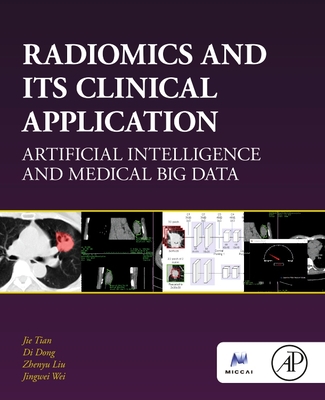Radiomics and Radiogenomics: Technical Basis and Clinical Applications
暫譯: 放射組學與放射基因組學:技術基礎與臨床應用
Li, Ruijiang, Xing, Lei, Napel, Sandy
- 出版商: CRC
- 出版日期: 2021-03-31
- 售價: $2,730
- 貴賓價: 9.5 折 $2,594
- 語言: 英文
- 頁數: 484
- 裝訂: Quality Paper - also called trade paper
- ISBN: 0367779587
- ISBN-13: 9780367779580
-
相關分類:
Data-mining
海外代購書籍(需單獨結帳)
相關主題
商品描述
Radiomics and Radiogenomics: Technical Basis and Clinical Applications provides a first summary of the overlapping fields of radiomics and radiogenomics, showcasing how they are being used to evaluate disease characteristics and correlate with treatment response and patient prognosis. It explains the fundamental principles, technical bases, and clinical applications with a focus on oncology. The book's expert authors present computational approaches for extracting imaging features that help to detect and characterize disease tissues for improving diagnosis, prognosis, and evaluation of therapy response. This book is intended for audiences including imaging scientists, medical physicists, as well as medical professionals and specialists such as diagnostic radiologists, radiation oncologists, and medical oncologists.
Features
- Provides a first complete overview of the technical underpinnings and clinical applications of radiomics and radiogenomics
- Shows how they are improving diagnostic and prognostic decisions with greater efficacy
- Discusses the image informatics, quantitative imaging, feature extraction, predictive modeling, software tools, and other key areas
- Covers applications in oncology and beyond, covering all major disease sites in separate chapters
- Includes an introduction to basic principles and discussion of emerging research directions with a roadmap to clinical translation
商品描述(中文翻譯)
《放射組學與放射基因組學:技術基礎與臨床應用》提供了放射組學與放射基因組學這兩個重疊領域的首次綜述,展示了它們如何用於評估疾病特徵並與治療反應及患者預後相關聯。書中解釋了基本原則、技術基礎和臨床應用,重點放在腫瘤學上。該書的專家作者提出了提取影像特徵的計算方法,這些特徵有助於檢測和表徵疾病組織,以改善診斷、預後和治療反應的評估。本書適合影像科學家、醫學物理學家以及診斷放射科醫師、放射腫瘤科醫師和醫學腫瘤科醫師等醫療專業人員和專家閱讀。
**特色**
- 提供放射組學與放射基因組學的技術基礎和臨床應用的完整概述
- 展示它們如何以更高的效能改善診斷和預後決策
- 討論影像資訊學、定量影像、特徵提取、預測建模、軟體工具及其他關鍵領域
- 涵蓋腫瘤學及其他領域的應用,並在各章中涵蓋所有主要疾病部位
- 包含基本原則的介紹及對新興研究方向的討論,並提供臨床轉化的路線圖
作者簡介
Ruijiang Li, PhD, is an Assistant Professor and ABR-certified medical physicist in the Department of Radiation Oncology at Stanford University School of Medicine. He is also an affiliated faculty member of the Integrative Biomedical Imaging Informatics at Stanford (IBIIS), a departmental section within Radiology. He has a broad background and training in medical imaging, with specific expertise in quantitative image analysis and machine learning as well as their applications in radiology and radiation oncology. He has received many nationally recognized awards, including the NIH Pathway to Independence (K99/R00) Award, ASTRO Clinical/Basic Science Research Award, ASTRO Basic/Translational Science Award, etc.
Dr. Lei Xing is the Jacob Haimson Professor of Medical Physics and Director of Medical Physics Division of Radiation Oncology Department at Stanford University. He also holds affiliate faculty positions in Department of Electrical engineering, Medical Informatics, Bio-X and Molecular Imaging Program at Stanford. Dr. Xing's research has been focused on inverse treatment planning, tomographic image reconstruction, CT, optical and PET imaging instrumentations, image guided interventions, nanomedicine, imaging informatics and analysis, and applications of molecular imaging in radiation oncology. Dr. Xing is an author on more than 280 peer reviewed publications, a co-inventor on many issued and pending patents, and a co-investigator or principal investigator on numerous NIH, DOD, ACS and corporate grants. He is a fellow of AAPM (American Association of Physicists in Medicine) and AIMBE (American Institute for Medical and Biological Engineering).
Dr. Sandy Napel is Professor of Radiology, and Professor of Medicine and Electrical Engineering (by courtesy) at Stanford University. His primary interests are in developing diagnostic and therapy-planning applications and strategies for the acquisition, visualization, and quantitation of multi-dimensional medical imaging data. He is the co-director of the Radiology 3D and Quantitative Imaging Lab, and co-Director of IBIIS (Integrative Biomedical Imaging Informatics at Stanford).
Daniel L. Rubin, MD, MS, is Associate Professor of Radiology and Medicine (Biomedical Informatics Research) at Stanford University. He is Principal Investigator of two centers in the National Cancer Institute's Quantitative Imaging Network (QIN), Chair of the QIN Executive Committee, Chair of the Informatics Committee of the ECOG-ACRIN cooperative group, and past Chair of the RadLex Steering Committee of the Radiological Society of North America. His NIH-funded research program focuses on quantitative imaging and integrating imaging data with clinical and molecular data to discover imaging phenotypes that can predict the underlying biology, define disease subtypes, and personalize treatment. He is a Fellow of the American College of Medical Informatics and haspublished over 160 scientific publications in biomedical imaging informatics and radiology.
作者簡介(中文翻譯)
李瑞江博士是史丹佛大學醫學院放射腫瘤學系的助理教授及ABR認證的醫學物理學家。他同時也是史丹佛大學整合生物醫學影像資訊學(IBIIS)的一名附屬教員,該部門隸屬於放射科。他在醫學影像方面擁有廣泛的背景和訓練,專長於定量影像分析和機器學習,以及它們在放射學和放射腫瘤學中的應用。他獲得了許多全國認可的獎項,包括NIH獨立之路(K99/R00)獎、ASTRO臨床/基礎科學研究獎、ASTRO基礎/轉譯科學獎等。
邢磊博士是史丹佛大學醫學物理學的雅各·海姆森教授及放射腫瘤學系醫學物理部的主任。他同時在史丹佛大學的電機工程系、醫學資訊學、生物醫學計畫(Bio-X)和分子影像計畫擔任附屬教員。邢博士的研究專注於逆向治療計畫、斷層影像重建、CT、光學和PET影像儀器、影像引導介入、納米醫學、影像資訊學和分析,以及分子影像在放射腫瘤學中的應用。邢博士是280多篇經過同行評審的出版物的作者,許多已發和待發專利的共同發明人,以及多項NIH、DOD、ACS和企業贊助的共同研究者或主要研究者。他是美國醫學物理學會(AAPM)和美國醫學與生物工程學會(AIMBE)的會士。
桑迪·納佩爾博士是史丹佛大學的放射科教授,以及醫學和電機工程(兼任)的教授。他的主要研究興趣在於開發診斷和治療計畫應用及策略,以獲取、可視化和量化多維醫學影像數據。他是放射科3D和定量影像實驗室的共同主任,以及IBIIS(史丹佛整合生物醫學影像資訊學)的共同主任。
丹尼爾·L·魯賓醫生是史丹佛大學放射科和醫學(生物醫學資訊研究)的副教授。他是國家癌症研究所定量影像網絡(QIN)中兩個中心的主要研究者,QIN執行委員會的主席,ECOG-ACRIN合作小組的資訊委員會主席,以及北美放射學會RadLex指導委員會的前主席。他的NIH資助研究計畫專注於定量影像,並將影像數據與臨床和分子數據整合,以發現能預測潛在生物學的影像表型,定義疾病亞型,並個性化治療。他是美國醫學資訊學會的會士,並在生物醫學影像資訊學和放射學領域發表了超過160篇科學出版物。











